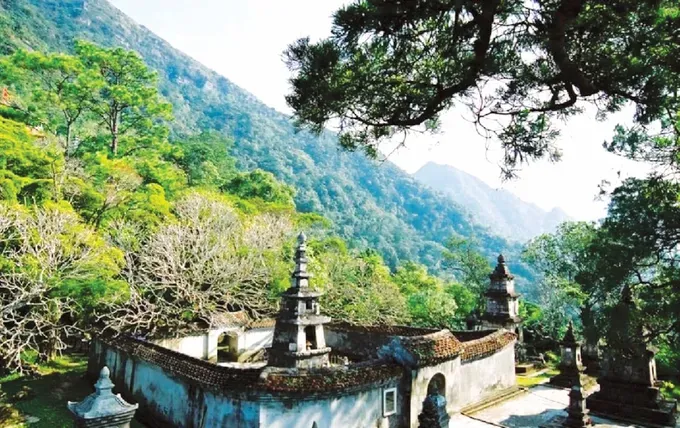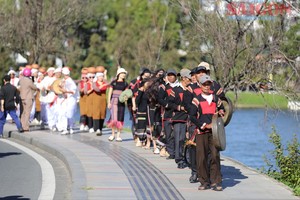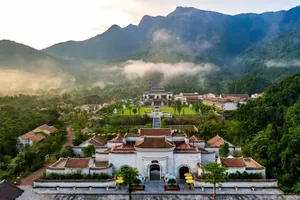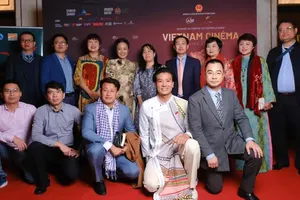This recognition represents not only a source of cultural pride but also a milestone demonstrating the potential to realize an inter-provincial world heritage in Vietnam. How to seize opportunities, promote, and effectively develop the interconnected spatial and cultural values of the heritage is a problem that needs to be solved.

In the afternoon of July 12 (Paris time), at the 47th Session of the World Heritage Committee of the United Nations Educational, Scientific and Cultural Organisation (UNESCO), Professor Nikolay Nenov, Chairman of the Session, officially knocked the hammer to recognize the Yen Tu-Vinh Nghiem-Con Son-Kiep Bac Relics and Landscape Complex as a World Cultural Heritage site.
This is the 9th world heritage of Vietnam and the second inter-provincial world heritage, after Ha Long Bay - Cat Ba Archipelago in Quang Ninh and Hai Phong.
This heritage complex stands out not only for its remarkable architecture and natural landscape but also for its profound connection to the formation and development of the Truc Lam Zen sect, a distinctly Vietnamese school of Buddhism founded by King Monk Tran Nhan Tong.
The harmonious interplay between the state, religion, and local communities in creating and preserving this cultural legacy is a key reason why UNESCO granted its recognition, underscoring Vietnam’s exceptional cultural stature on the world stage.
According to Associate Professor Dr. Bui Hoai Son, a specialized member of the National Assembly’s Committee for Culture and Society, UNESCO’s recognition of the complex is not only a source of national pride but also a reminder of the responsibility to comprehensively preserve and promote the heritage. Restoration and landscape conservation alone are not enough; it also needs a cross-sectoral strategic vision that treats heritage as a “living school,” a place where culture, religion, and history converge and become a driving force for sustainable development.
Meanwhile, tourism experts stated that it needs to develop a “heritage corridor” connecting the Northeast and Kinh Bac (Northern) regions, aiming to provide an opportunity for visitors to explore destinations. In the long term, a key priority lies in training a dedicated workforce in culture, tourism, and religious affairs—the guardians and storytellers of the heritage who can bring its legacy to life.
UNESCO recognition is only the beginning. Vietnam must transform this heritage into a living force, a Buddhist cultural center of Asia, standing alongside Kyoto in Japan, Lumbini in Nepal, and Bodh Gaya in India, Associate Professor Dr. Bui Hoai Son remarked.
Promoting and enhancing value

The recognition of the heritage site is not only a great honor but also comes with significant responsibilities. As Quang Ninh, Bac Ninh, and Hai Phong gain UNESCO recognition for the Yen Tu–Vinh Nghiem–Con Son–Kiep Bac heritage complex, these localities have the opportunity to promote the national image and the challenge of how to preserve the site’s authenticity while fostering sustainable tourism without allowing the heritage to become overly commercialized.
Permanent Deputy Minister of Foreign Affairs Nguyen Minh Vu, Chairman of the Vietnam National Commission for UNESCO, emphasized that once established as a global brand, it is essential to develop corresponding products from pilgrimage tours and meditation retreats to ecotourism, all planned within an inter-provincial spatial framework.
Lessons from the first inter-provincial World Natural Heritage, Ha Long Bay - Cat Ba Archipelago in Quang Ninh and Hai Phong, show the vital role of coordination mechanisms. Previously, connections between Quang Ninh and Hai Phong faced numerous challenges due to a lack of unified planning. Since its UNESCO recognition in September 2023, new opportunities for joint development have emerged.
According to Mr. Ha Pham, CEO of a tourism company, Cat Ba has become an extension of Ha Long Bay, opening up new development space where localities no longer compete but collaborate to share mutual benefits.
Connecting the two heritage regions not only boosts visitor numbers but also contributes to sustainable economic development. However, challenges such as benefit-sharing, resource conservation, and unified management remain critical issues to address. Currently, Ha Long Bay offers 11 tours, including three that connect to Lan Ha Bay. In the long term, a comprehensive master plan covering both bays is needed to clearly delineate conservation and development zones while developing linked tourism products that provide diverse and high-quality experiences.
Associate Professor Dr. Le Thi Thu Hien, Director of the Department of Cultural Heritage, said that in addition to media coordination, building a common brand identity, and the application of digital technology for guidance and international promotion, the most crucial factor remains connecting the heritage with the community. Residents, artisans, and religious practitioners must become the primary beneficiaries and active participants in the preservation. If the community does not see itself as the owner of heritage, sustainability cannot be achieved.
























